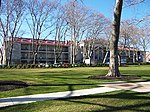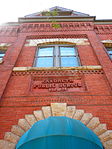Grays Road Recreation Center
Buildings and structures completed in 1927Buildings and structures on the National Register of Historic Places in PhiladelphiaColonial Revival architecture in PennsylvaniaPhiladelphia County, Pennsylvania Registered Historic Place stubsSouth Philadelphia

Grays Road Recreation Center is a historic recreation center located in the Grays Ferry neighborhood of Philadelphia, Pennsylvania. It was designed by John T. Windrim and built in 1926–1927. It is a 2+1⁄2-story, five-bay by nine-bay, red-brick building on in the Colonial Revival style. It has a gable roof with dormers, centrally placed arched entryway with stone surround, and two internal brick chimneys. The interior features a two-story auditorium, measuring 50 feet by 30 feet. The building was funded by the Richard Smith Family Trust.It was added to the National Register of Historic Places in 1988.
Excerpt from the Wikipedia article Grays Road Recreation Center (License: CC BY-SA 3.0, Authors, Images).Grays Road Recreation Center
Christian Street, Philadelphia South Philadelphia
Geographical coordinates (GPS) Address Website Nearby Places Show on map
Geographical coordinates (GPS)
| Latitude | Longitude |
|---|---|
| N 39.942222222222 ° | E -75.185 ° |
Address
Lancaster Farms CSA Drop Site
Christian Street 2521
19146 Philadelphia, South Philadelphia
Pennsylvania, United States
Open on Google Maps







